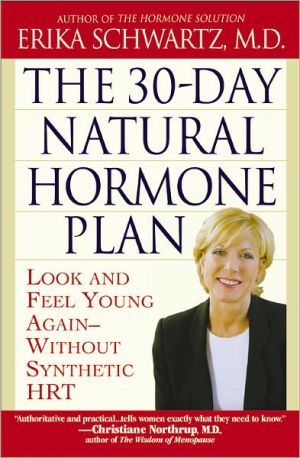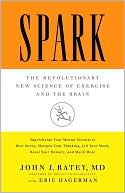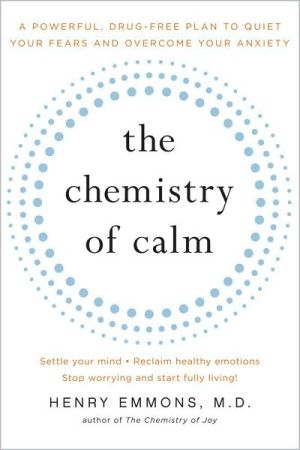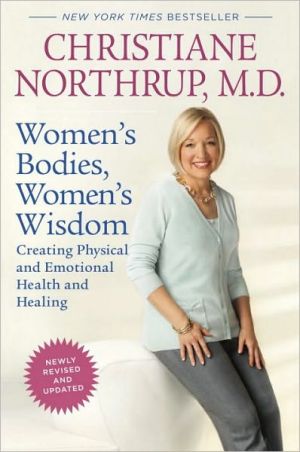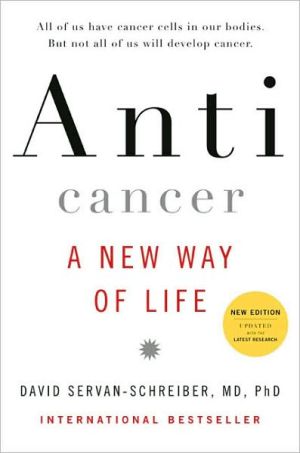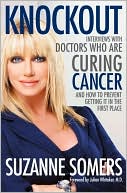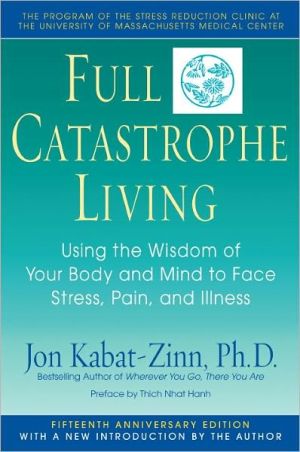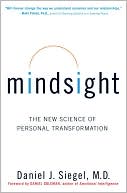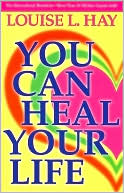The 30-Day Natural Hormone Plan: Look and Feel Young Again--Without Synthetic Hrt
Finally, an Alternative to Synthetic HRT That's Effective and That You Can Trust! Even after the National Institutes of Health halted its ten-year study in 2002, new findings continue to link synthetic hormone replacements with cancer and other diseases. Now Erika Schwartz, M.D., an expert in natural hormone therapy and founder of The International Hormone Institute, offers a day-by-day program that has already helped thousands of women (and men too!)-without synthetic HRT. Incorporating the...
Search in google:
Finally, an Alternative to Synthetic HRT That's Effective and That You Can Trust! Even after the National Institutes of Health halted its ten-year study in 2002, new findings continue to link synthetic hormone replacements with cancer and other diseases. Now Erika Schwartz, M.D., an expert in natural hormone therapy and founder of The International Hormone Institute, offers a day-by-day program that has already helped thousands of women (and men too!)-without synthetic HRT. Incorporating the supervised use of natural hormones, supplements, vitamins, diet, exercise, and lifestyle changes, this program helps you: • Feel younger, stronger, and more energetic in just days-no matter what your age • Eliminate the symptoms of pre-menopause or menopause-including hot flashes, loss of libido, depression, and mood swings • Solve health problems that may have been plaguing you since puberty • End many food cravings for good • Flush out the toxins in your body that throw hormones out of balance • Make exercise a simple, joyous part of your daily routine.
30-Day Natural Hormone Plan\ Look and Feel Young Again - Without Synthetic HRT \ \ By Erika Schwartz \ Warner Books\ Copyright © 2004 Erika Schwartz\ All right reserved.\ ISBN: 0-446-53255-X \ \ \ \ Chapter One\ Hormones are powerful agents of change in our body. They cause direct changes in our bodily functions and facilitate our body's reactions to environmental changes. All of us-men, women, adults, and adolescents-experience constant hormone fluctuations. How we look and feel is the direct result of our hormone balance.\ When our hormones are in balance, meaning all our hormones are working together well, the results are amazing. Our skin looks radiant and fresh, our minds work smoothly, we remember things, we focus well, our weight and moods are stable, our sex drive soars. We are young and healthy.\ When our hormones are out of balance, problems can develop. We have difficulty focusing, we get tired and stay tired, we can't catch up on sleep. We become insomniacs, lose interest in sex, get bloated, and gain weight. We develop aches and pains in our joints; our skin gets wrinkled and dry; we get heart disease, digestive problems, arthritis, osteoporosis. We age.\ The aging process is the result of years of wear and tear on our body. It mirrors the state of our hormone balance, our genetics, and the type of life we lead.\ Understanding how our hormone balance affects everything we do in our lives is key to maintaining health and preventing aging from robbing us of vitality.\ The need to understand and make the connection between hormone balance and lifestyle, diet, exercise, stress, sleep, and every part of our lives prompted me to develop the 30-Day Plan.\ The goal of the program is to help keep you healthy and youthful for as long as possible. To take you there, we must first gain insight into the connection between health (hormones in balance) and physical and mental deterioration (hormones out of balance). Once this insight is achieved, the 30-Day Plan helps integrate natural hormones, supplements, diet, exercise, and lifestyle into your whole life and effectively accomplish the dream of staying well and delaying the destructive effects of aging on the body and mind.\ This book contains all the simple tools and information you need to accomplish the anti-aging goal and to understand the messages that your own body sends you. In addition to the diet, exercise, and lifestyle portions, I will reinforce the balancing program with simple and easily available combinations of natural hormones and supplements.\ The natural hormones I endorse and advise you to use are approved by the U.S. Food and Drug Administration (FDA) and have been on the market for twenty years with long track records of safety along with extensive clinical experience in the United States, Canada, and Europe.\ The supplements and vitamins I recommend are backed up by reliable and respected scientific research and substantial clinical data that support their safety and efficacy. They are accepted and in use by both conventional medicine and alternative therapies.\ But until now, these products have not been combined in the context of a comprehensive program. My 30-Day Plan is the result of more than twenty-five years of experience as a doctor helping solve all types of hormone problems from which my patients have been suffering. Up to now, the information contained in this book was only available to the limited number of people who could be my patients. Now you and your physician can share the 30-Day Plan and help achieve perfect hormonal balance for your body and mind.\ The 30-Day Plan will help you integrate your diet, exercise, and lifestyle into a successful hormone-balancing, anti-aging package that uses common sense and proven medical knowledge.\ UNDERSTANDING HORMONES\ Before we get started, we need to understand what hormones are, and that they are all involved in achieving the balance we need to feel healthy.\ Hormones are products of living cells that circulate in our bodily fluids and produce specific effects on the activity of other cells far removed from the organs where the hormones are made. They stimulate or inhibit the actions of cells everywhere in the body. No organ is left untouched by the actions of hormones.\ There are hundreds of hormones in our bodies, and they have innumerable jobs. They regulate all bodily functions and interact with each other at all times. No hormone acts on its own. The action of one hormone affects the action of many others and the results vary, depending on infinite internal and external factors.\ Hormones are produced through chemical processes by glands and organs in specialized cells. They are made from fatty acids, various combinations of protein components called amino acids, and certain sugar molecules. Most hormones are, in fact, derived from a familiar substance, cholesterol. This is one reason cholesterol should not be dismissed as no more than the culprit behind fatty deposits in our arteries that cause heart disease or stroke. Without cholesterol, our body cannot make hormones-and that's an even graver danger.\ Here's a partial list of the better-known and -researched hormones. This list will give you an idea of their names and how their presence is ubiquitous:\ Insulin.\ Growth hormone.\ Thyroid hormones (triiodothyonine [T3] and thyroxine [T4]).\ Parathyroid hormone (parathormone).\ Calcitonin.\ Estrogen.\ Progesterone.\ Testosterone.\ Stomach hormones (gastrin, pepsin, trypsin, secretin, and others).\ Adrenal hormones (cortisol, aldosterone).\ Kidney hormones (renin).\ Lung hormones (angiotensin).\ Brain hormones (serotonin, melatonin, dopamine, luteinizing hormone, follicle-stimulating hormone, prolactin, adrenaline, endorphins, norepinephrine).\ Looking at this list, you probably recognize some familiar names. Some of these, like adrenaline, serotonin, and dopamine, are often called neurotransmitters. They're still hormones, only they're categorized under a specific grouping of hormones that enhance or delay transmission of messages in the nervous system, and in the brain in particular. Another group, estrogen, progesterone, and testosterone, are the sex hormones. Both men and women have all three of them, but they vary in concentration according to your gender.\ Some of these hormones are "good" hormones, while others are not. The good hormones help improve well-being and memory, maintain sugar balance, and stimulate positive reactions in your body. The "bad" hormones, when they are out of balance, can be destructive and increase wear and tear on your mind and your internal organs.\ Examples of good hormones are: serotonin, progesterone, testosterone, glucagon, aldosterone, dopamine, and growth hormone.\ Examples of bad hormones are: cortisol, insulin, and sometimes estrogen.\ What's important to remember is that there is no such thing as an independent hormone action. Every action affects everything else going on. Every hormone interacts with others. For us to feel good and stay healthy, every hormone has to work in balance and synchrony. When we look at a list of effects of individual hormones, we are looking at only a small part of the picture.\ HORMONES IN BALANCE If hormones can be said to have a goal in life, it is to maintain what is called homeostasis, which means that they are constantly working to keep us in a state of equilibrium. They strive to maintain balance inside the body regardless of outside environmental conditions. In order to maintain this balance, they react to everything we do. And I mean everything-like eating, sleeping, reading, running, breathing, hugging, having sex, daydreaming, sitting, standing, even thinking.\ Remember: Many hormones are working at the same time. This is why no one hormone-or no one anything (vitamin, food, supplement, medication)-will balance us, keep us young, or protect us from our own individual ways of destroying our bodies. And this is why your goal in life should be the same as your hormones'-to achieve homeostasis, through which you can stay healthy and enjoy life.\ HORMONES OUT OF WHACK\ In an ideal world, we'd all be in homeostasis all the time. But even in the best of times, we don't live in an ideal world. We live busy lives, sad lives, happy lives, working lives, playing lives-all at the same time. Our hormones are constantly adapting to the changes we experience throughout every single day.\ Remember: Hormone levels change whenever we change. Regardless of age, as long as we are alive, our hormone levels are changing continuously. When our lives take a new direction, when a stress appears or disappears, our hormone balance changes. If we are lucky enough to have a well-balanced life and are aware of these changes, we can preempt or minimize the problems. But even if we're able to rapidly rebalance, we never totally prevent the most common reaction, hormones out of whack.\ Lucy was fifty-eight when I first saw her. She had been a physical education teacher. Diet, exercise, and great personal care were part of her life. Two years earlier, she and her husband won the lottery. They didn't have children or family ties in New York where they lived and decided to retire to Florida. With no worries about work or money, they had only sunny days to look forward to-until the unexpected happened.\ Lucy had sailed through menopause at forty-five with almost no symptoms. But now she suddenly started having severe hot flashes, night sweats, insomnia, and mood swings. Suffering with almost incapacitating symptoms, Lucy was convinced she had cancer. She saw three doctors: an internist, an endocrinologist, and a gynecologist. Diagnoses of Lyme disease, arthritis, diabetes, thyroid problems, and cancer were considered but discarded. Finally one of the physicians told Lucy that her problems were probably hormone related, but there was nothing that could be done.\ The physician was right about the cause of her symptoms- her problems were an outgrowth of hormone imbalance. But he was wrong when he said there was no solution. When Lucy came to me, I treated her with a combination of natural hormones: estradiol and micronized progesterone in cream form. But treating the symptoms is not always enough. I knew it was essential to find out what had triggered Lucy's sudden hormone imbalance.\ I asked Lucy to start a journal. It turned out that for her (as for many other people), retirement was more stressful than her busy life had been. She missed the city life. The stress of the move, and the change of climate and emotional environment, had pushed her delicate hormone balance over the edge. Her hormones were going crazy trying to adjust to so many changes at once.\ Within three months, following my program of natural hormones, supplementation, and journaling, Lucy gained a better understanding of her new life and began to feel herself again.\ Hormones out of whack can be caused by the smallest of changes in your internal and/or external environments. Never underestimate or overlook any part of your life when doing the detective work of finding what caused your hormones to lose their balance.\ Unfortunately, it's all too easy to throw your own hormones out of whack. I know; I've done it myself. I have personally been using natural/bioidentical hormones, the supplement regimen, and the 30-Day Plan for more than five years. Occasionally, however, I behave like every other human being and lose my balance. A perfect example: I had been doing well for months. My hormones were in perfect synchrony. My eating habits were impeccable, and my life was running smoothly without too much stress. A perfect time to throw off my hormone balance-and it all started with a cup of coffee.\ I love coffee. Unfortunately, coffee doesn't like me, so I generally avoid it. But one day, I found myself with a yen for coffee. I decided to have just one espresso. I did. No symptoms. I advanced to a double. Still no problem. Within three days, I was drinking two cups of coffee a day. I started getting a little heartburn. I took some Zantac. The heartburn was gone and I continued my coffees. I knew the coffee was causing the heartburn, but I chose to ignore that fact.\ Within one week, I started waking up in the middle of the night with night sweats. During the day I experienced an occasional hot flash. Within another few days, I found myself exhausted all the time. Soon after, I started craving sweets, and my commitment to exercise suddenly disappeared. Faced with all these changes, I thought I might be taking too high a dose of natural hormones, so I decreased my dose. My symptoms worsened. Finally, after two weeks of feeling crummy, I decided to face reality. My hormones were out of whack and everything I did added to the problem. I stopped the coffee, went back on my usual dosage of natural hormones, cleaned up my eating act, and got back on track. It took two weeks to get back to normal. The lesson learned? I'm fifty-two, my body cannot tolerate coffee, and I have to listen to it if I want to feel good. The lesson relearned? The balance of hormones is precarious, and one small thing can set off a domino effect, pushing everything out of control.\ The 30-Day Plan will help prevent the dominoes from falling and robbing you of precious wellness time. By following the advice in these pages, you will be able to quickly identify the culprits that disturb your hormone balance. By the time you're finished with this book, your hormones will no longer be a mystery, and understanding how to help maintain their balance will be second nature.\ MENARCHE TO MENOPAUSE-WHO SUFFERS FROM HORMONE IMBALANCE?\ While preparing to write The Hormone Solution, I reviewed the records of five hundred patients (covering the years 1997 through 2001) in my own practice, looking at the age distribution for women with diagnoses related to hormone imbalances. The demographics revealed an almost even distribution between menopausal women and women ranging in age from sixteen to forty-five.\ The results seemed unusual, but I was sure I wasn't misdiagnosing these women. They all had thorough and complete medical evaluations and blood tests from other doctors before they came to me. Their extensive and expensive workups confused and scared them, but offered them no solutions. But when I put them on my 30-Day Plan and began balancing their hormones, their symptoms consistently disappeared.\ Which led me to ask: How often do symptoms of hormone imbalance in young women go unnoticed and undiagnosed in the general population? Clearly these young women were not aberrations. They were suffering with severe premenstrual syndrome (PMS), bloating, breast tenderness, mood swings, loss of sex drive, hot flashes, and night sweats. These were serious symptoms and needed to be brought into the open and addressed.\ \ Continues...\ \ \ \ Excerpted from 30-Day Natural Hormone Plan by Erika Schwartz Copyright © 2004 by Erika Schwartz. Excerpted by permission.\ All rights reserved. No part of this excerpt may be reproduced or reprinted without permission in writing from the publisher.\ Excerpts are provided by Dial-A-Book Inc. solely for the personal use of visitors to this web site. \ \
PrefacexiIntroduction: Why the 30-Day Plan?xiiiAuthor's NotexviiPart IHormones 1011Chapter 1What Everyone Needs to Know3Chapter 2How Your Life Affects Your Hormones and How Your Hormones Make or Break Your Life19Chapter 3The Natural Hormone Solution: What Are the Alternatives to Synthetics?50Part IIThe Essential Elements of the 30-Day Plan65Chapter 4Before You Begin the Program67Chapter 5Feeding Your Hormones: Your Diet, Your Body, Your Life77Chapter 6Exercise: Hormonal Benefits of Working Out100Chapter 7Supplements: What You Need for Best Results108Chapter 8Journaling Your Hormone Shifts125Part IIIDr. Erika's 30-Day Plan135Chapter 9The Journey Begins: Days 1-5137Chapter 10Getting into Gear: Days 6-10163Chapter 11Hormone-Friendly Recipes, Part 1187Chapter 12Moving Up to Speed: Days 11-15192Chapter 13Keep Up the Good Work: Days 16-20217Chapter 14Almost There: Days 21-25242Chapter 15In Balance: Days 26-30268Chapter 16Hormone-Friendly Recipes, Part 2294Chapter 17And Life Goes On... Special Situations and Lifelong Maintenance307Part IVThe Politics of Hormones319Chapter 18Synthetic Suicide: The National Institutes of Health/Women's Health Initiative Study and Its Aftermath321Chapter 19A Final Word332Glossary334Resources348Recommended Reading351References354Index368
\ Publishers WeeklySchwartz (The Hormone Solution), a practicing physician specializing in natural hormones, provides a 30-day program that relies on the use of natural hormones to alleviate menopausal symptoms such as lack of libido, bone loss, insomnia and depression that often beset women. Schwartz clearly explains that while synthetic hormone replacement therapy interferes with human hormones, natural hormones made from plants are identical to hormones in the human body. She recommends working with a physician to establish an individualized treatment program. In addition to natural hormone therapy, Schwartz's 30-day program for maintaining good health while aging, relies equally on a combination of diet and exercise. The strength of Schwartz's program is that it's designed to be gradually introduced into one's lifestyle. For example, positive dietary changes are initiated over a period of weeks; at the same time, sugary processed foods, caffeine and alcohol are reduced or eliminated slowly. Included are two chapters on hormone friendly recipes. These strategies will be helpful to menopausal women and others with hormonal imbalance who want to avoid any possible health risks in taking synthetic hormones. (Jan.) Copyright 2003 Reed Business Information.\ \ \ \ \ Library JournalIn the wake of findings by the National Institutes of Health on the dangers of synthetic hormones, Schwartz (The Hormone Solution) wrote this book, which puts forth a 30-day plan for perimenopausal and menopausal women, to "jump-start and maintain a healthy rest-of-your-life." Much of the information on exercise and food can be found in similar sources, e.g., The Doctors Book of Home Remedies for Managing Menopause, edited by Mary S. Kittel. What makes Schwartz's book different are her "prescriptions": she divides her plan into manageable daily chunks that include detailed recommendations for plant-based natural hormones (available on a prescription-only basis), diet, supplements, and exercise; all of these recommendations feature recipes for main dishes and snacks. It is notable that Schwartz does not offer information about the safety of natural hormones for breast cancer survivors but does for the problems of eating out, ethnic-food choices, and the politics of hormones. Readers will also find journal pages, a glossary, a list of online resources and recommended reading, a bibliography of articles from both medical and popular literature, and contact information for companies that sell natural hormones. Appropriate for public libraries lacking new titles in this area. (Index not seen.)-Martha E. Stone, Massachusetts General Hosp. Lib., Boston Copyright 2003 Reed Business Information.\ \
